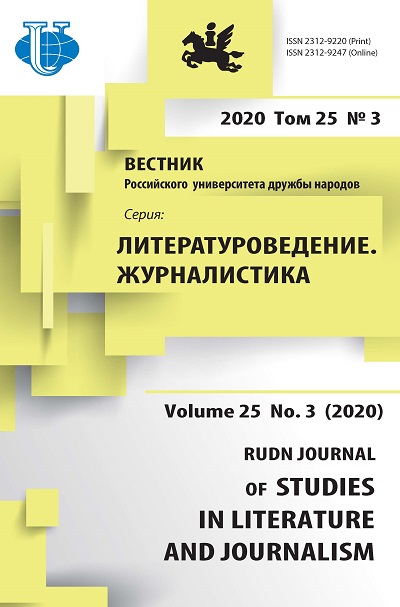The phenomenon of fan creativity: the main directions of studies
- Authors: Algavi L.O.1, Kharchenko A.V.1
-
Affiliations:
- Peoples’ Friendship University of Russia (RUDN University)
- Issue: Vol 25, No 3 (2020)
- Pages: 531-541
- Section: JOURNALISM
- URL: https://journals.rudn.ru/literary-criticism/article/view/24829
- DOI: https://doi.org/10.22363/2312-9220-2020-25-3-531-541
Cite item
Full Text
Abstract
The article considers the main directions of foreign and domestic studies of fan communities and fan creative production. The article synthesizes theoretical knowledge collected abroad. Media fandoms are understood as interpretive, participatory communities that are able to influence media production. Fanfiction is shown as one of the forms of expression of criticism and various potential interpretations and meanings of the original work. The Russian scientific community also refers to fan communities as “interpretive communities”. Fanfiction is defined as a literary work that performs the function of demonstrating a variety of individual reader’s interpretations of the work. It was revealed that despite the existence of some differences in approaches to the study of fan creativity, there is a common focus on the activity of the audience. More attention is given to the study of collective meaning-making and ways of expressing different interpretations of the original media product.
About the authors
Leila O. Algavi
Peoples’ Friendship University of Russia (RUDN University)
Author for correspondence.
Email: algawy_lo@rudn.ru
Candidate of Philology, Associate Professor at the Department of Theory and History of Journalism of the Faculty of Philology
10 Miklukho-Maklaya St, bldg 2, Moscow, 117198, Russian FederationAlina V. Kharchenko
Peoples’ Friendship University of Russia (RUDN University)
Email: alva.kharchenko@gmail.com
candidate for a degree of PhD in Philology of the Department of Mass Communications of the Faculty of Philology
10 Miklukho-Maklaya St, bldg 2, Moscow, 117198, Russian FederationReferences
- Hellekson, K. (2018). The Fan Experience. A Companion to Media Fandom and Fan Studies. John Wiley & Sons.
- Tulloch, J. (2000). Watching Television Audiences: Cultural Theories & Methods. London, UK, Arnold.
- Brooker, W., et al. (eds.). (2001). The Audience Studies Reader. Psychology Press, 2003.
- Hall, S. (2001). Encoding/Decoding. Media and Cultural Studies. Keyworks. London: Blackwell Publishers.
- Morley, D.G. (1980). The Nationwide Audience. British Film Institute.
- Fish, S. (1976). Interpreting the “Variorum”. Critical Inquiry, 2(3), 465–485.
- Jenkins, H. (2018). Fandom, Negotiation, and Participatory Culture. A Companion to Media Fandom and Fan Studies (pp. 13–26).
- Jenkins, H. (2012). Textual Poachers: Television Fans and Participatory Culture. Routledge.
- Jenkins, H. (2009). Confronting the Challenges of Participatory Culture: Media Education for the 21st Century. MIT Press.
- Kelty, C., et al. (2015). Seven Dimensions of Contemporary Participation Disentangled. Journal of the Association for Information Science and Technology, 66(3), 474–488.
- Prasolova, K.A. (2008). Fanfikshn: Literaturnyj fenomen konca XX – nachala XXI veka (tvorchestvo poklonnikov Dzh.K. Roling) [Fanfiction: A literary phenomenon of the late XX – early XXI century (the work of fans of J.K. Rowling)] (Dissertation of the Candidate of Philological Sciences). Kaliningrad.
- Sokolova, N.L. (2011). Transmedia i “interpretativnye soobshhestva” [Transmedia and “interpretative communities”]. Mezhdunarodnyj zhurnal issledovanij kul'tury [International Journal of Cultural Studies], 3(4), 16–21.
- Timoshenko, E.K. (2015). Strategii rossijskogo fanfikshena po romanu L.N. Tolstogo “Vojna i mir” [Strategies of Russian fanfiction based on the novel by L.N. Tolstoy “War and Peace”]. Bulletin of Udmurt University. History and Philology Series, (6), 89–94.
- Goralik, L. (2003). Kak razmnozhajutsja Malfoi: Zhanr “fjenfik”: Potrebitel' masskul'tury v dialoge s mediakontentom [How Malfoys reproduce: Genre “fanfiction”: Consumer of mass culture in dialogue with media content]. Novyj mir [New world], (12), 131–146.
- Busse, K. (2017). Intimate Intertextuality and Performative Fragments in Media Fanfiction. Fandom: Identities and Communities in a Mediated World (pp. 45–60).
- Busse K., & Hellekson, K. (2006). Introduction: Work in Progress. Fan Fiction and Fan Communities in the Age of the Internet. Jefferson, McFarland & Company.
- Korobko, M.A. (2015). Priznak kollektivnosti v fanfikshn i pis'mennyh formah sovremennogo fol'klora [A sign of collectivity in fan fiction and written forms of modern folklore]. The Bryansk State University Herald, (1), 220–223.
- Fedorchuk, M.A. (2017). Specifika tekstoporozhdenija v fanfikshn (na materiale russkojazychnyh fandomov) [Specificity of text production in fan fiction (based on Russian-language fandoms)] (Dissertation of the Candidate of Philological Sciences). Orel.
- Rozanov, K.A. (2010). Studencheskaja zhizn' v novejshej rossijskoj internet-literature [Student life in the latest Russian Internet literature] (Abstract of the Dissertation of the Candidate of Philological Sciences). Saratov, Saratov State University.
- Antipina, Ju.V. (2011). Literaturnoe internet-tvorchestvo fanatov: Pedagogicheskij aspekt [Literary Internet creativity of fans: Pedagogical aspect]. Sborniki konferencij NIC “Sociosfera” [Conference proceedings of the research center “Sociosphere”], (2), 121–125.
















